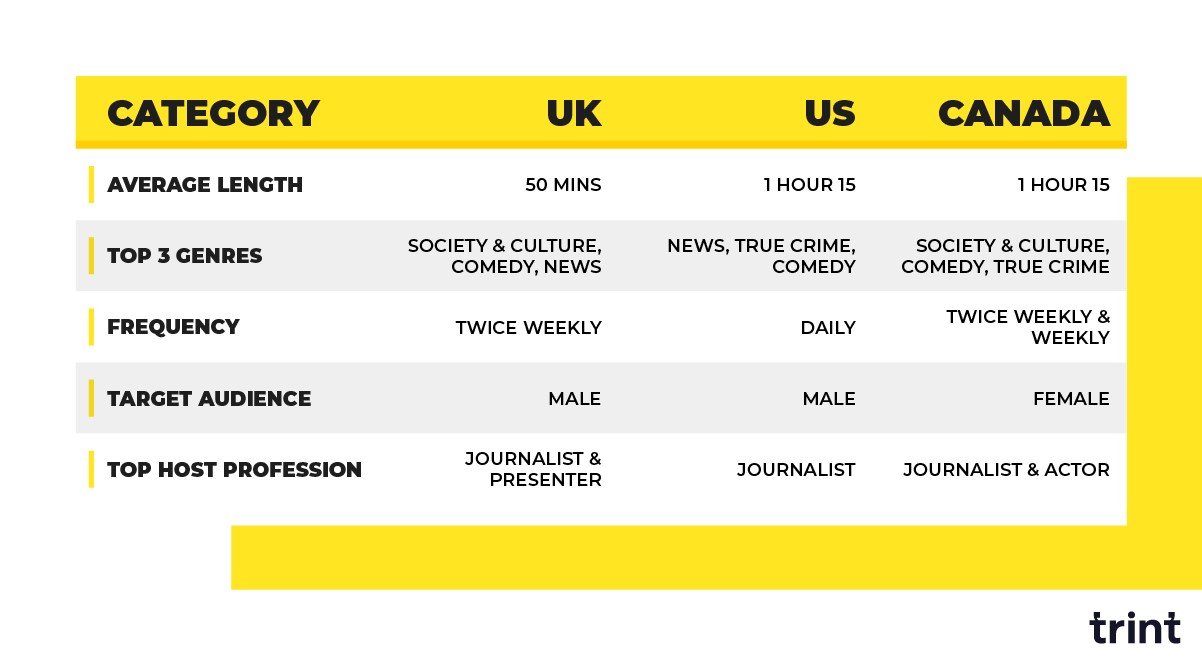According to Ofcom research, 20% of the UK population listen to at least one podcast a week. With a potential audience of 11.7 million dedicated podcast listeners from varying demographics, podcasting can have huge benefits for the host, brand and advertisers from awareness to tangible traffic and sales generation. But with millions of podcasts, and counting, worldwide, what is the formula for success?
To help answer this question, transcription and content creation experts, Trint, have conducted research into the most listened to and profitable podcasts in the UK and beyond.
Looking into various data elements including number of listeners and demographic, Trint have analysed what sets these popular podcasts out from the rest.
Podcast preferences by region
 The first thing that jumps out? Regional preferences can shape your content strategy. Understanding your audience and how they interact with podcasts can help you tailor your show and brand to match their habits and interests. After all, knowing your listeners is half the battle to making your podcast stand out.
The first thing that jumps out? Regional preferences can shape your content strategy. Understanding your audience and how they interact with podcasts can help you tailor your show and brand to match their habits and interests. After all, knowing your listeners is half the battle to making your podcast stand out.
Length
The US and Canada love a dose of long-form audio content. Top podcasts last over an hour on average as North American listeners value in-depth conversations they can dive into. Meanwhile, in the UK, podcasts under an hour tend to be more popular. This allocates enough time to dive deep into a topic without losing the attention of your audience. It’s also the perfect length for anyone listening on their commute or during their lunch break.
Frequency
For the US, consistency is key and listeners want as much content as possible. Daily podcasts are a favorite in the States, with 50% of top podcasts posting every day. This is compared to the 38% that post twice weekly and just 12% that post weekly content. If you’re a podcaster targeting this region, considering a lengthier and more frequent format might be a smart move. In contrast, the UK and Canada prefer twice-weekly or even weekly posts, balancing consistency without overwhelming listeners.
Genre
Comedy and culture podcasts dominate globally, but genre preferences still vary by region. True crime finds a stronger foothold in North America, particularly in Canada. Nearly 23% of top Canadian podcasts fall under the true crime genre. However, if you’re producing a podcast in the UK or US, leaning into news commentary or humor might work better than focusing on crime stories.
Audience
While the majority of podcast listeners in the UK and US are male, Canada is unique with its stronger appeal to a predominantly female audience. Genre plays a key role here: news podcasts, popular in both the UK and US, often attract male listeners. Meanwhile, Canada’s obsession with true crime flips the script, drawing a predominantly female audience. Of the top Canadian podcasts, 54% had an audience that skewed female.
The power of journalism
Across all three regions, podcasts hosted by journalists top the charts. Their knack for storytelling and credibility seems to strike a chord with listeners, especially in genres like news and true crime. In fact, Jeff Kofman, journalist, founder and CEO of Trint, hosts his own podcast, StoryTech, where he interviews big names like Emmy-nominated director Jeremy Podeswa and more to focus and incorporate their professional stories into the podcast.
When it comes to guests, star power matters. Podcasts with celebrity guests tend to do better than those interviewing industry or thought leaders, largely because a celebrity’s name alone can capture attention. Many celebrities also amplify podcast episodes by promoting them on their own social platforms, massively increasing their reach and engagement.
Going visual: The role of video
Think a podcast is all audio? Think again. While not every top show has a dedicated YouTube presence, most incorporate some form of visual element. In fact, nearly 84% of top podcasts used YouTube as part of their strategy.
Whether it’s video snippets shared on social media or fully recorded episodes for YouTube, visuals boost your content’s accessibility and draw in viewers who might not otherwise listen.
Social media savvy
You’ve heard it time and time again, but social media is essential if you want to get the word out. Our research shows that posting at least one Instagram post per episode can significantly boost visibility. This doesn’t have to be anything complicated or time-consuming either, a simple engaging teaser video for your social media channels works well.
Podcasts with a predominantly female audience are particularly active on socials, taking it a step further and often replying to comments to build engagement. These interactions may seem small, but they help turn casual listeners into loyal followers.
While you’re at it, it’s worth setting up a website for your show too. Many successful podcasts use their website as a hub for extra content — whether it’s behind-the-scenes content, bonus episodes or exclusive resources. A website deepens the connection with your audience and gives them more ways to engage with your show.

